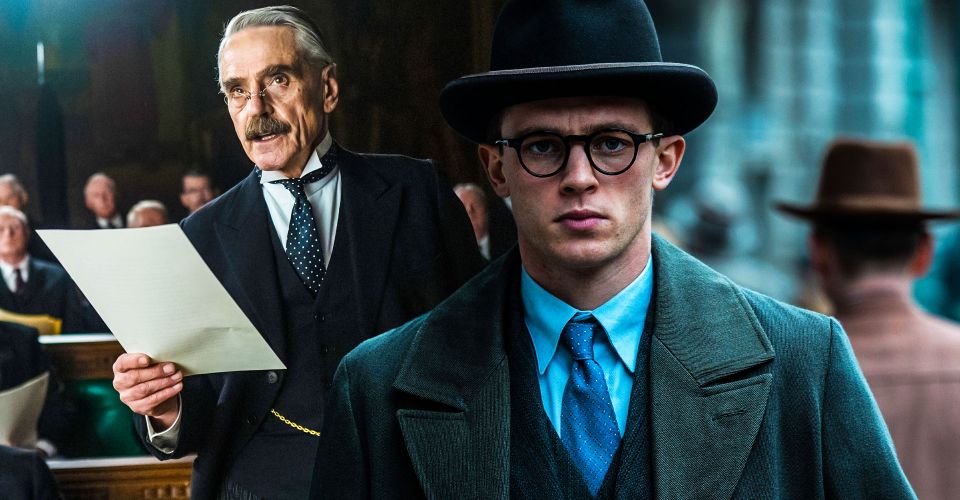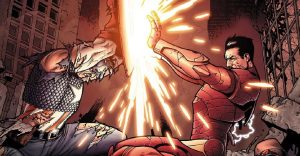Munich: The Edge Of War Ending Explained & What Happened Next

Warning: Spoilers for Netflix’s Munich: The Edge of War.
Munich: The Edge of War‘s ending leaves several narrative codas that need to be explained in the context of what happened next historically. Helmed by fledgling director Christian Schwochow, Munich: The Edge of War is based upon the novel of the same name by eminent English writer Robert Harris, whose forte lies in works of historical fiction. It is fitting, then, that Munich: The Edge of War‘s ending serves as a blend of fact and fiction that ties into the last months of peace prior to the outbreak of World War II.
Munich: The Edge of War’s story of twisting political narrative converges on the ill-fated Munich Conference, a two-day summit held in September 1938 in which British, French and other European government leaders met to discuss Adolf Hitler’s (Ulrich Matthes) plans to annex neighboring Czechoslovakia. The British diplomacy efforts are led by Prime Minister Neville Chamberlain (Jeremy Irons), who is dead set on pursuing peace by any means, including appeasing the dangerous Nazi Party leader. Running parallel to the conference itself, British diplomat Hugh Legat (George MacKay) is tasked by MI6 to work with his long-time friend Paul von Hartmann (Jannis Niewöhner), who is now operating covertly from within the German government to bring down Hitler’s fascist reign.
Posited by Netflix as a historical drama, the movie adaptation of Munich: The Edge of War instead acts as a revisionist period piece designed to paint the pre-war British delegation in a much more favorable light. Schwochow’s film also, at times, plays like a thriller despite his audience already knowing that this particular tableau ends in war, with several unexpected twists refusing to conform to the well-trodden World War II narrative. Here’s Munich: The Edge of War’s ending explained, as well as what happened next in the real world.
How Much Of Munich: The Edge Of War Was Real?

Much of Munich: The Edge of War‘s period setting is highly accurate against 1938, with the filming locations of Berlin, Potsdam, Munich, and several parts of England adding authenticity to Schwochow’s carefully timelined drama. The film also pays particular attention to detail to the pre-war aesthetic of Europe, with each delegation’s signature dress recreated with dazzling attention to detail. Netflix has excelled in recent years at blending fictionalized true stories with real historical characters and Munich: The Edge of War is no different. Within these details are also nestled several characters based on real-life historical figures that form the backbone of Munich: The Edge of War‘s narrative.
The film’s main protagonist Neville Chamberlain is a well-known figure from Britain’s historical archives who was the country’s Prime Minister from 1937 to 1940. Chamberlain did publically attend the Munich conference of 1938, where his main aim was to spare Europe the horrors of war, although his motivations for doing so were more politically motivated in real life. Chamberlain’s nemesis in Munich: The Edge of War, Adolf Hitler, is also an accurate representation of the dictator in his pre-war years, with the actor Matthes truly capturing Hitler’s ever-swelling God complex and political drive in a striking performance. The film’s Paul von Hartmann (more on him later) and Sir Osmund Cleverly (Mark Lewis Jones) are also based on real people, although their characters are severely altered from their real-world counterparts.
Why Paul Didn’t Assassinate Hitler & What Happened To Him

In the penultimate scene, Munich: The Edge of War character Paul von Hartmann prepares to shoot Hitler in his chambers after Hugh confirms they have failed to deliver the Nazi plans into Allied hands. Paul’s chance arrives when a member of his covert team allows him a window to assassinate Hitler, but Paul fails to pull the trigger, missing the opportunity. This split-second decision is due to Hitler and Paul’s conversation, in which Paul’s own responses to the Führer remind him that “the German people are scared of war.” At this moment, Paul realizes that killing Hitler could be the catalyst for war rather than preventing it, with Hitler’s death likely to engage a German military and population already primed for conflict, bringing the exact horror upon his country that he has been striving to avoid.
Hartmann’s character is loosely based on the real-life anti-Nazi diplomat Adam von Trott zu Solz, a German lawyer and politician involved in the conservative resistance to Nazism during Hiter’s rise to power. In the years that followed the Munich Agreement, Trott’s true story is fascinating, with the covert operative involved in several campaigns to undermine the Third Reich’s influence and reputation across Germany. Nearing desperation and before the Allies turned the tide of the war on the beaches of Normandy, Trott became one of the leaders of Colonel Claus von Stauffenberg’s plot to assassinate Hitler in July 1944, with the daring plot’s failure consigning Trott to execution that same year.
How Long The Munich Agreement Lasted In WWII

Munich: The Edge of War goes to painstaking lengths to display that Chamberlain’s Munich Agreement was a vital brokerage of peace. Yet in the film’s coda, the final messages on-screen confirm the Munich Agreement was broken in less than a year following Hitler’s admission to his SS general Franz Sauer (August Diehl) that he would “rip up” the agreement regardless of its terms. Hitler’s flagrant disregard for the treaty saw him invade Poland against the terms of the Munich Agreement, triggering the start of World War II in Europe on September 3rd, 1939.
Neville Chamberlain’s Resignation & True Story Explained

While Munich: The Edge of War paints Chamberlain in a stoic, selfless light as a man willing to sacrifice anything to save Europe, the British politician’s true story is a far more controversial one. Munich: The Edge of War‘s historical setting is impressively accurate, yet the reason Chamberlain aggressively pursued appeasing Hitler was primarily due to his public political stance in Britain, and one which he could not back down from. Many historians posit that Chamberlain’s hubris aided him in believing Hitler would honor the Munich Agreement and not start World War II when in fact, there were ample warning signs that Hitler was already preparing his forces to invade Poland and break the contract.
In the closing captions, Munich: The Edge of War also touches briefly on Chamberlain’s death, although it does not explain why. In real life, Chamberlain’s public embarrassment after being forced to declare war on Germany just months after the Munich Agreement left him in an untenable political position, with both the Labor and Liberal parties of the time refusing to serve under him. As a result, Chamberlain resigned from office in 1940, with the former Prime Minister dying of cancer just six months later in October that same year. Munich: The Edge of War‘s spy-thriller ending posits that Chamberlain’s efforts in Munich gave Britain a vital year to prepare for war, but in the context of the real pre-war years, many still believe to this day that Chamberlain’s appeasement is what emboldened Hitler to continue his plans against Europe in the first place.
About The Author

















